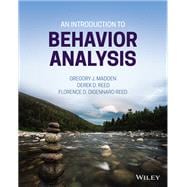Explore a fascinating introductory treatment of the principles of behavior analysis written by three leading voices in the field
An Introduction to Behavior Analysis delivers an engaging and comprehensive introduction to the concepts and applications for graduate students of behavior analysis. Written from the ground up to capture and hold student interest, the book keeps its focus on practical issues.
The book offers readers sound analyses of Pavlovian and operant learning, reinforcement and punishment, motivation and stimulus control, language and rule-following, decision-making and clinical behavior analysis. With fully up to date empirical research references and theoretical content, An Introduction to Behavior Analysis thoroughly justifies every principle it describes with empirical support and explicitly points out where more data are required.
The text encourages students to analyze their own experiences and some foundational findings in the field in a way that minimizes jargon and maximizes engagement. Readers will also benefit from the inclusion of:
Perfect for students taking their first course in behavior analysis or behavior modification, An Introduction to Behavior Analysis will also earn a place in the libraries of students pursuing certification through the Behavior Analysis Certification Board or taking courses in the applied psychological sciences.








